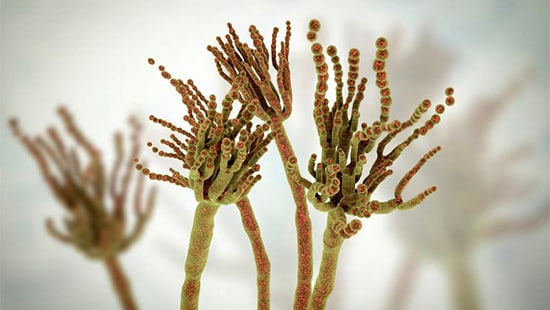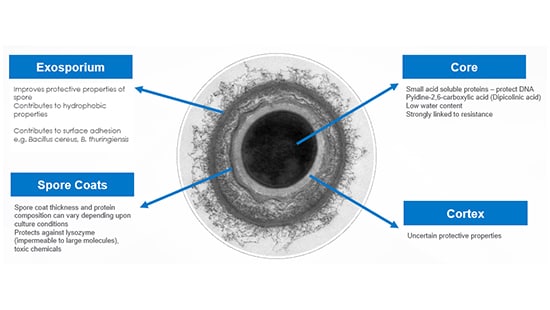Myths and Pitfalls of Bacterial and Fungal Spores
As any good microbiologist will be able to tell you killing vegetative microbes is one thing, destroying spores are quite another. Why is that? Can all spores be treated equally? This article aims to explain why microbial spores and those from bacteria, in particular, can be problematic in industry.

Figure 1: A Fungal Spore A Fruiting Body
What is a microbial spore and what is it not? Broadly speaking spores are a survival mechanism utilized by the microorganism in times of stress, starvation, or attack. Seeds and pollen from the plant kingdom are a good comparison here. While the seed from a plant can and does give rise to a new plant, it remains dormant until conditions for germination are favorable. Seeds have two basic functions to perform in order to be successful. One is to protect the genetic material stored within the seed and the second is to aid its dispersion from the parent plant. The function of a bacterial spore is much the same.
It is not only bacteria that demonstrate sporulation. When nutrients are abundant fungi exist as a filamentous mass (mycelium). Individual strands of the fungi, known as hyphae extrude digestive enzymes into the surrounding nutrients. They absorb the nutrients from an environment rich in food. When the levels of nutrients are low, or other stress factors are encountered (lack of moisture for example) then a change occurs in how the Fungi grows. Hyphae in stressed areas on the mycelium begin to form fruiting bodies which grow up into the air. Prominent examples of fruiting bodies are mushrooms and toadstools, these fruiting bodies are designed for the same purpose. They produce tens of thousands of fungal spores which disperse into the air. Some even create their own weather to aid dispersal – for example, mushrooms release water vapor, which cools the surrounding air, pulling spores released by the mushroom, down and away from it allowing dispersion to occur.
Fungal spores have evolved to aid the dispersal of the organism to areas free from competition or high in nutrients. Fungal spores, in a similar way to plant seeds and bacterial spores, are also robust and designed to survive in the environment for extended periods of time. Fungal spores can be seen as ‘offspring’ of the main organism. [See Figure 1]
A limited number of bacterial species are also capable of forming spores in response to environmental stress. There are two types of bacterial spore, the exospore and the endospore. Exospores are also known as microbial cysts and are not as resistant as endospores, which this article will focus on. Not all bacteria can form endospores, only those of the phylum Firmicutes can produce them, an example being the Bacillus and Clostridia.
Unlike fungal spores which come from specific large structures, the fruiting bodies, endospores form within in a bacterial cell (Exospores form outside of the bacterial cell). The formation of an endospore is usually in response to a lack of available nutrients in the environment and this triggers the survival mechanism in the cell. Unlike fungal spores, endospore formation is not a means of producing offspring, it is a mechanism for protecting the individual bacterial cell.
Bacterial endospores, once formed, are incredibly resilient. Scientific publications mention that scientists can routinely isolate and recover viable spores over ten thousand years old. Less common is the recovery of viable spores from over 40 million years ago (this is 32 million years before humans first begin to evolve on earth). There is one scientific report of the recovery of viable Bacillus spores from a staggering 250 million years ago – this is before the dinosaurs roamed across the earth’s surface.

Figure 2: A Spore
Bacterial endospores are, by their very nature, resistant to attack from the external environment. In this modern day and age this includes methods of sterilisation and chemical disinfection. Endospores are more resistant to chemicals or other processes that can easily kill vegetative cells.

Figure 3: The Resistance of Spores
Both fungal and bacillus spores are able to spread or survive in very hostile environments, a degree of confusion is often seen when trying to deal with these contaminants using disinfectants. This in turn has given rise to some confusion in the pharmaceutical industry when trying to eradicate microbial bioburden from surfaces.
The following four points might be helpful ‘myth busters’ to guide you in appropriate disinfection:
- Fungal spores, while more resilient than vegetative cells are significantly less resistant than bacterial endospores. A number of broad-spectrum bactericides are more than capable of destroying fungal spores. Therefore the use of a sporicidal agent may not always be required when trying to control or eradicate fungal spores from a cleanroom.
- There are different resistance profiles for different species of bacteria producing endospores. In the food or healthcare industry Clostridia spp. (bacteria) are significant pathogenic microorganisms. Their presence in these environments are cause for significant alarm and they must be eradicated. In the pharmaceutical industry, it is more relevant to test the Bacillus spp. because these are more resistant than Clostridia. A sporicidal disinfectant should be used to destroy bacterial endospores from the Bacillus spp and if you can destroy these, you are covered for Clostridium.
- An occasional observation I have seen from customers is the lack of a sporicidal disinfectant used as part of their routine rotational strategy. One of the reasons for this is a belief that in a given population of spore forming bacteria, they will all form spores at the same time, in response to changing environmental factors. While vegetative cells exposed to these broad-spectrum bactericides will be killed, in reality endospore formation will occur at different times in a bacterial population. This is due to a variety of factors such as cell age, exposure to stress or even position in a population. This means that even if a bactericidal disinfectant is regularly applied, the spores will still be formed and persist in a cleanroom environment.
- A final failing sometimes encountered in the industry is the infrequent use of sporicides and the use only coming after spore-forming bacteria have been detected (reactive rather than preventative). There are a number of reasons for doing this, primarily is the Health and Safety risk to people and potential damage to facilities from these aggressive chemistries. By taking a reactive approach to the recovery of spore-forming bacteria you are allowing them to develop in your critical areas, increasing the risk of them entering the product. By proactively rotating sporicides with routine broad-spectrum disinfectants you are the reducing the risk of spore-forming bacteria causing contamination.
In conclusion, bacteria and fungi have evolved mechanisms for aiding their proliferation and survival in response to hostile environmental conditions. This resilience needs to be understood when a site is looking at its disinfectant portfolio. Careful consideration should be given to the selection of organisms used in disinfectant validation and the selection of disinfectants used routinely in the facility. We are here to provide technical guidance.



